There are countless great guitar riffs in Muse’s discography and many of them are easy enough for beginners to learn.
If you’re looking at learning some riffs to work on your rhythm skills, the Muse guitar riffs covered in this lesson are a great starting point.
Most of these Muse songs are in Drop D tuning. If you’ve never played in Drop D before, learn about Drop D Tuning here. Drop D is an easy alternate tuning to change into, so don’t be put off by any of these riffs being in Drop D.
Guitar TAB is included for each guitar riff. Find out how to read Guitar TAB here before you start this guide.
Reapers
Reapers is a song from Muse’s 2015 album, Drones.

The song is filled with some fun riffs and techniques such as tapping, funky chord strumming, string skipping, and tremolo picking.
If you’re an intermediate guitarist, you’ll have a lot of fun learning this song.
If you want to learn this full song, you’ll need a Whammy pedal such as the DigiTech Whammy DT (link to review), which is used throughout the song and during the tapping sections. Find out how to use a Whammy pedal here.
While I highly recommend checking out the tapping section, the riff I want to highlight is the groovy stop-and-start riff used before the chorus.
How to Play This Riff
Riff Tempo: 96 bpm
Tuning: Drop D (D A D G B E)

There are a few things to keep in mind when learning this riff:
Take your time. This type of riff only works if you learn to play it perfectly. Your timing needs to be spot on or it won’t feel right.
Start out slow and memorize all of the notes. Then use a metronome set at half speed (48 bpm) and practice playing along with it with perfect timing.
If it feels easy at this tempo, gradually increase the tempo.
Aim for consistency. All of the notes in this riff apart from the power chords are sixteenth notes. This means they all ring out for the same length of time.
Because you’ll be jumping back and forth between two strings, you need to be careful that you don’t play some notes faster than others. Make sure the pull-offs are also consistent with the picked notes.
If you’re able to play every note consistently, the riff will sound and feel much better.
Control your palm muting. The use of palm muting helps add character to this riff. If you play the riff without any palm muting, you’re not going to get that chunky and percussive tone you hear in the song.
Pay attention to the points where you add or remove your palm from the strings. Play the notes and power chords that don’t use palm muting harder to emphasize those notes.
Play along with the song. This is a type of riff that you need to practice along with the backing instruments to learn properly.
While you should use a metronome in the beginning to help learn the rhythm and feel comfortable with the riff, you should move on to playing along with the drums and bass.
You can either play along with the actual song or download the Guitar Pro file for the song from a Guitar TAB website.
Why You Should Learn This Riff
What makes this one of the best Muse riffs is the feeling you get when you play it properly. It’s unlike any of the other riffs in this lesson.
Once you memorize the order of the notes and you feel comfortable with the rhythm, you will start to get into a groove. If you play along with the song, you’ll start to understand why it’s such a great guitar riff.
If you don’t get this feeling that I’m talking about when you play this riff, take it as a sign that you need to keep practicing.
Supermassive Black Hole
Supermassive Black Hole was the lead single from Muse’s 2006 album, Black Holes and Revelations.

Supermassive Black Hole is a great song for a beginner to learn due to the simple rhythm and riffs used throughout the song.
The riff I want to highlight here is the iconic opening guitar riff.
It’s a great riff to learn to help you work on your timing. Being able to start and stop each of the open string notes at the right time is crucial to playing the riff properly.
How to Play This Riff
Riff Tempo: 120 bpm
Tuning: Standard (E A D G B E)

Apart from the flurry of notes at the very end, the rest of this riff is very easy to learn.
All you’re doing is alternating between the open E string and the 10th fret.
But getting this riff to sound good will take some practice.
The first thing to do is to memorize the pattern. Listen to the song a few times and get used to the way the riff stops and starts.
With the bends on the 10th fret, you only need to slightly bend the string. A quarter bend should sound half-way between the 10th and 11th fret pitches.
You can use either your fretting hand or your picking hand (or both) to mute the strings any time you see the rest symbol on the top staff (learn how to read rest symbols here).
With the last few notes, start by playing it slowly. You need to play the bend, then smoothly play the hammer-on, pull-off, then pick the 2nd fret on the next string.
This flurry of notes will be awkward at first, but if you practice it enough, it will start to feel easy.
Why You Should Learn This Riff
This riff will teach you how important rests are in creating an interesting rhythm.
The rests are just as important to get right as the notes. If you try to play this riff without the rests, it will sound terrible. So pay attention to the rests and practice them properly.
The punchy tone that comes across when you hear this riff is completely due to the rests.
Hysteria
Hysteria is from Muse’s third album from 2003, Absolution.

Hysteria is well known for the epic bass riff that opens the song. But the opening guitar riff is a great example of how to write a guitar riff that complements a great bass riff.
How to Play This Riff
Riff Tempo: 94bpm
Tuning: Standard (E A D G B E)

This is a very simple riff to play, as long as you get the timing right.
Pay attention to the rhythm of the octaves and make sure you mute the strings properly before you move to play the bend.
Sometimes Guitar TABs will place an ‘x’ in between the two strings so you know that it’s okay to strum across the strings.
To play an octave, place your first finger on the bottom note (12th fret in the first bar) and your third finger on the higher note (14th fret). Let your first finger lightly touch the fourth string to mute it. Now you can strum the strings and you should only hear two notes ring out.
If you’ve never played octaves before, they’re used a lot in this style of music so it’s worth spending some time to practice this riff.
Play the bends with your third finger (ring) and make sure you bend up to the correct pitch (should sound one fret higher) before bringing the note back down.
Why You Should Learn This Riff
What makes this guitar riff great is that it goes against what most guitarists would play.
When you first hear the epic bass riff at the start of the song, you would expect that when the guitar comes in, it would follow along and play the same thing.
The fact that Matt doesn’t just follow the bass is why it’s such a great riff. Most other guitarists would simply double-up what the bass is playing.
By playing something completely different to what the bass is playing, it improves the song.
If you play in a band or write your own songs, this is a great example of how to write a great riff.
Knights of Cydonia
No list of best Muse songs would be complete without mentioning Knights of Cydonia.

Knights of Cydonia is from Muse’s 2006 album, Black Holes and Revelations.
If you’re a Muse fan, I highly recommend learning this song from start to finish.
The main guitar riff makes use of a tremolo arm or whammy bar (find out about guitar parts here) and is a lot of fun to play.
The riff I will highlight in this lesson is later on in the song. It’s faster and harder to play compared to the slower main riff, but will be great fun to play once you master it.
How to Play This Riff
Riff Tempo: 135 bpm
Tuning: Standard (E A D G B E)
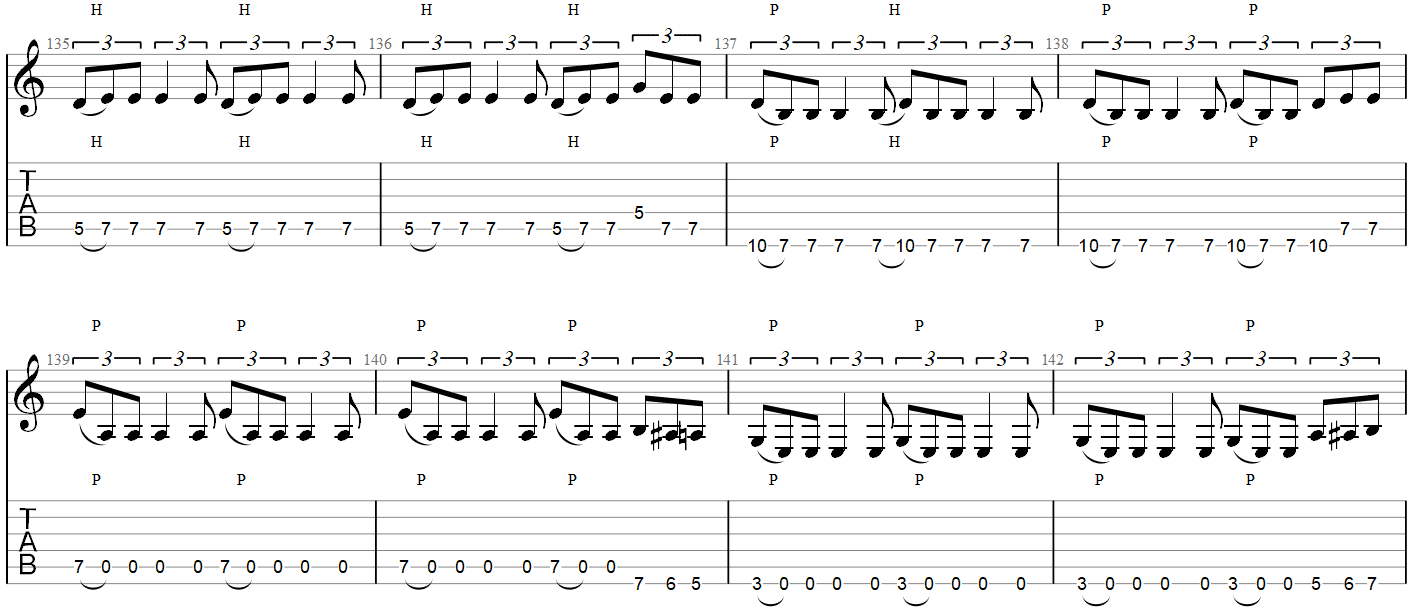
This is a fairly fast guitar riff, so take your time to get your picking right.
Start out slow if you need to and really think about your picking direction as you play.
You can play this using strict down-picking, alternate picking, or any combination you like.
The hammer-ons and pull-offs may feel awkward at first (some Guitar TABs mistakenly don’t include them), but they will help you get the right groove.
Once you can play the riff at full tempo, you’ll see how the hammer-ons and pull-offs add to the feel of this riff.
Why You Should Learn This Riff
This riff will give you excellent practice at playing a fast rhythm using hammer-ons and pull-offs.
Being able to keep a consistent tempo while jumping around the fretboard is a great skill to work on.
It’s a great guitar riff to play and in many ways more fun than the rest of the song.
New Born
New Born is from Muse’s 2001 album, Origin of Symmetry.

This song makes great use of a Whammy pedal in the solo as well as the main guitar riff. Check out my DigiTech Whammy DT review here to learn about Whammy pedals.
How to Play This Riff
Riff Tempo: 155 bpm
Tuning: Drop D (D A D G B E)
Effects used: Whammy pedal set one octave down to harmony mode (or use an octave pedal)
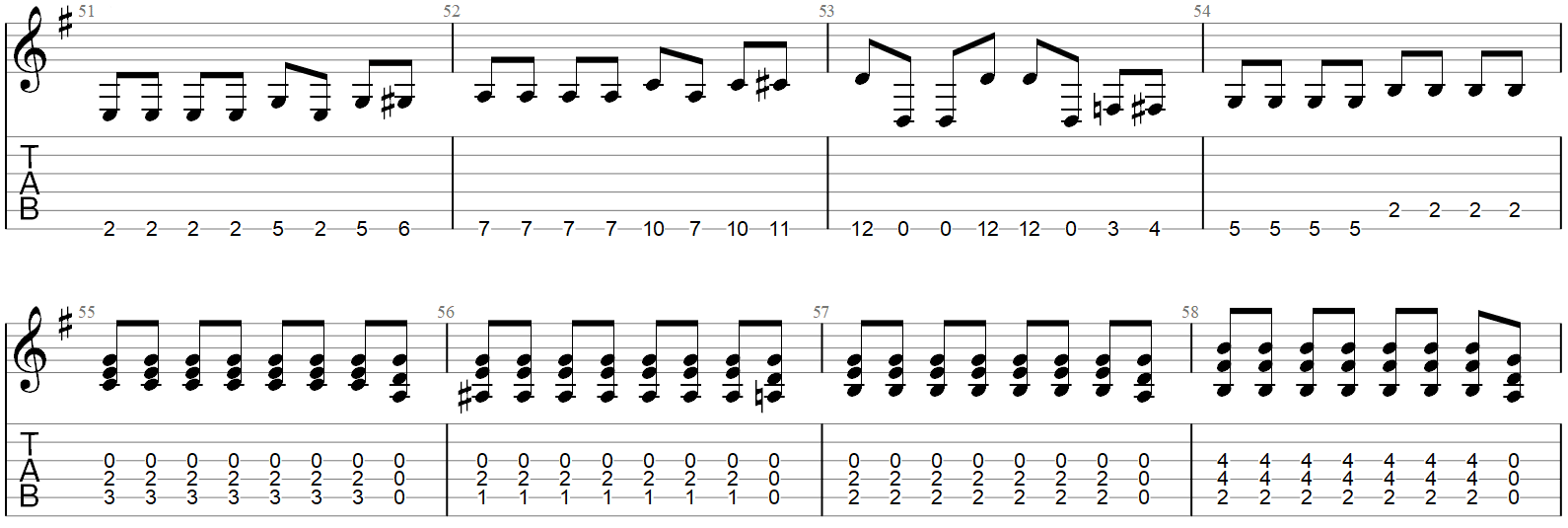
This is a fast riff, but apart from the speed, the only thing you need to think about is which fingers to use as you jump around the fretboard.
Start slowly and think about what fingers would make it easiest to jump between the different positions.
Gradually build up the tempo by playing along with a metronome.
Guitar Effects Used
To get your guitar tone to sound like the song, use an octave pedal or a Whammy pedal set to harmonize an octave below.
If you don’t want to use a Whammy pedal, any octave pedal will work.
I recommend the EHX Nano POG because you can use it to create tones an octave below or above (used in other songs such as Plug In Baby).

For this riff, turn the ‘Octave Up’ knob down to zero and turn the ‘Sub Octave’ knob up. Adjust the ‘Dry’ knob until you’re happy with the mix between the two signals.
Check out my Guitar Effects and Tone Course to learn all about pitch-shifting effects and other effects you will hear in Muse songs.
Why You Should Learn This Riff
This riff will give you great practice at playing a fast and aggressive style. The octave effect helps add to the aggressive sound and is a lot of fun to play.
If you try to play this riff without using an octave pedal or a Whammy pedal, it’s not going to feel or sound right.
There have already been two songs in this list that make use of a Whammy pedal, so I highly recommend getting one if you’re a Muse fan.
Plug In Baby
Plug In Baby was the lead single from Muse’s second album, Origin of Symmetry.
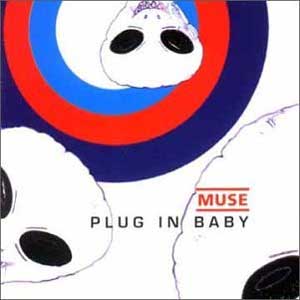

The iconic main riff you hear at the start of the song is a great challenge for beginners to learn without it being too hard.
How to Play This Riff
Riff Tempo: 136 bpm
Tuning: Standard (E A D G B E)
Effects Used: Whammy pedal (set to harmony +1 octave), fuzz distortion, phaser (used during live performances)


What makes this riff interesting is that while the riff only lasts for six bars (as shown above), the section in the song lasts for 14 bars.
This means you repeat the entire riff twice, then play the first two bars again before moving on to something else in the song.
Listen to the song and read the above TAB to get used to how you will play this riff. It might feel odd to play the riff two-and-a-bit times, but that’s part of what makes it interesting.
You can see that the rhythm is pretty simple and apart from the hammer-on and pull-off, or the bend, every note is an eighth note.
This makes it a great riff to practice along with a metronome and gradually build up your tempo.
If it feels too fast for you now, with some metronome practice it will eventually feel easy to play.
Guitar Effects Used
A big part of this riff is the guitar tone. The combination of unusually hairy distortion and harmonics takes this riff to a new level.
A fuzz distortion pedal is used to create a ‘hairy’ distortion. Find out about fuzz pedals in this guide.
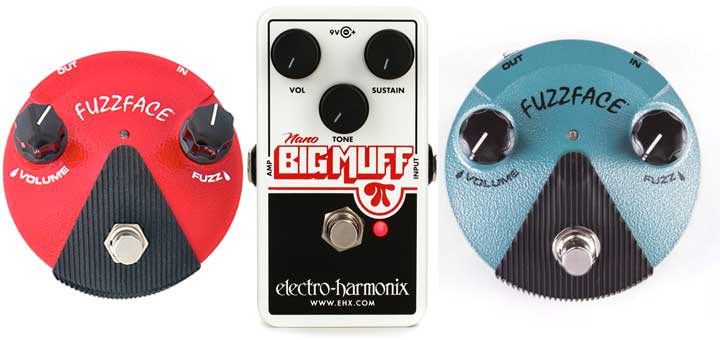

Fuzz distortion is a great effect to play around with and while it takes some time to learn how to use, it’s great fun.
During live performances, Matt combines the fuzz distortion with a Whammy pedal set to harmonize an octave higher.
You can see that on the DigiTech Whammy DT, the top left setting creates a harmony an octave higher or lower depending on the pedal position.
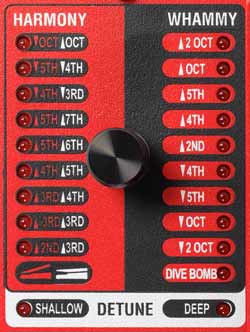

Alternatively, you can use an octave pedal such as the EHX Nano POG and turn the ‘Octave Up’ knob up and the ‘Sub Octave’ knob all the way down to zero.



This gives you a lot of control over the mix between your original signal and the pitch-shifted signal.
Finally, you may like to add a phaser pedal set to a very slow rate to add some subtle modulation.
This effect wasn’t used on the album, but it seems Matt uses some sort of modulation during live performances.
While the MXR Phase 90 is often recommended, I suggest using a pedal that gives you more control over the effect. Find out about phaser pedals in this guide along with recommendations.
Why You Should Learn This Riff
This riff will be a great way to work on your memorization skills as well as your picking technique.
It’s a guitar riff that sounds harder to play than it is. If you feel intimidated by it, take your time and you’ll be surprised by how easy it is to play.
Psycho
Psycho is from Muse’s seventh album, Drones.



This slow and heavy guitar riff makes great use of Drop D tuning. It’s incredibly easy to play and shows why Muse often uses Drop D.
How to Play This Riff
Riff Tempo: 125 bpm
Tuning: Drop D (D A D G B E)


The first part of this riff repeats the first two bars a few times, so get used to the slow and controlled bends.
With the very last bend on the 10th fret, try to bend it at the very last moment to give it a slight ‘pulling’ feeling.


During this section, you want a nice thick distortion setting to help emphasize the heavy feel of the song.
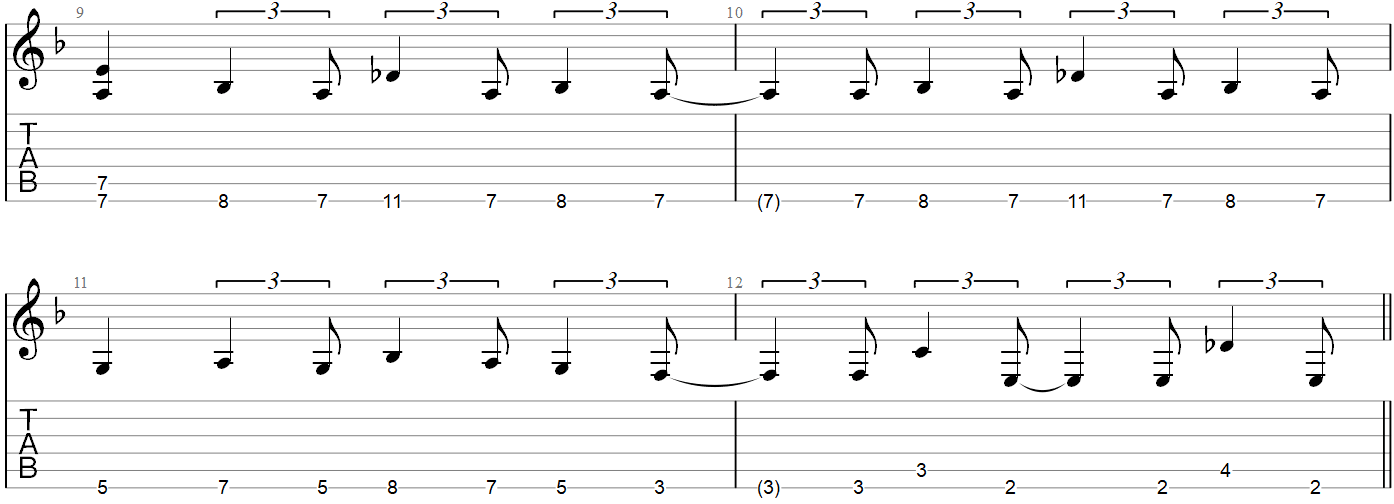

During this section, think about which fingers to use so you’re not jumping around while playing.
The stretch from the seventh to the eleventh fret may feel awkward at first.
If you have trouble holding your first finger down on the seventh fret and stretching that far, work on some of these finger exercises.
Why You Should Learn This Riff
This riff (and the entire song) is a great example of how much fun Drop D can be to play.
This song is incredibly easy to learn, so if you’re a beginner and want to learn some Muse songs, this is a good starting point.
Stockholm Syndrome
Stockholm Syndrome is from Muse’s third album, Absolution.
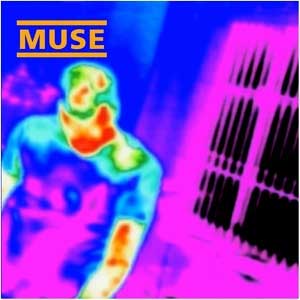

This is the fastest riff in this lesson, but with the right practice approach, anybody can learn it.
How to Play This Riff
Riff Tempo: 128 bpm
Tuning: Drop D (D A D G B E)


The biggest mistake you can make when trying to learn this song is to start off trying to play it fast.
While the pattern isn’t very complicated, you need to give yourself time to properly memorize the riff before you try to build up your speed.
Start by slowly memorizing the order of the notes until you can play it slowly by memory.
Once you have memorized the riff, start practicing along with a metronome set slower than you think you should set it.
You should set the metronome slow enough that you don’t make any mistakes and every note is perfect.
Gradually raise the tempo over a few days. Don’t push yourself too fast or else you’ll develop sloppy technique.
It doesn’t matter if it takes you weeks or months to reach full speed, as long as you have perfect timing by the time you reach full speed.
There’s no point in playing something fast if you play it sloppy. So take your time and develop complete control over this riff.
Why You Should Learn This Riff
This riff is a great way to practice fast picking and hand coordination.
Being able to play this riff perfectly at full speed is a great way to assess your abilities.
If you can master this riff, you’ll be able to play a lot of other fast riffs.
Supremacy
Supremacy is from Muse’s sixth album, The 2nd Law.


While this song was played with a 7-string guitar, as the below riff only uses one string, you can play it on a regular 6-string guitar by tuning the low E down to A.
How to Play This Riff
Riff Tempo: 80 bpm
Tuning: 7 String Drop A (A E A D G B E)
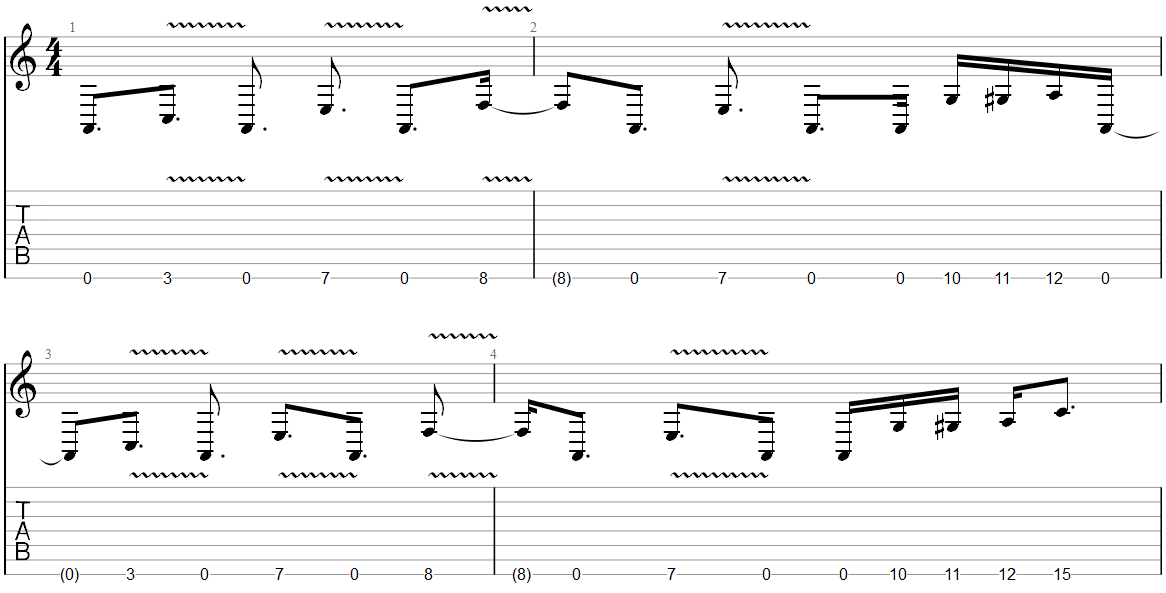

This is an easy riff to play, which means once you learn the technical side of it, you should spend some time working on getting the feeling right.
This song is meant to sound heavy, so give each note you play some weight.
The way you pick the strings and how hard you press down with your fingers play a big role in making something sound heavy.
Listen closely to the song to get an idea on how wide and fast to play the vibrato.
Why You Should Learn This Riff
This riff (and the rest of the song) is a great example of writing riffs that have weight.
While the super-low tuning does help make something sound heavy, the rhythm and the tone of each note plays an important part.
Take your time making this sound as heavy as possible. This has far more to do with your technique compared to your guitar amp settings.
The Handler
The Handler is from Muse’s 2015 album, Drones.



The main riff is one of the easiest riffs to learn in this lesson, but getting it to flow right will take some practice.
If you’re a beginner wanting to learn some Muse songs, this riff will get you used to jumping around the fretboard.
If you’re up for a memorization challenge, check out the legato lead section half-way through the song.
How to Play This Riff
Riff Tempo: 130 bpm
Tuning: Drop D (D A D G B E)


Start by practicing the first few bars and get used to sliding in and out of each position.
Once you are happy with the vibrato and slides, you can continue to learn the main riff.
Focus on getting your rhythm spot on with the backing instruments. You want to move into each new position at the exact right time to avoid sounding sloppy.
Why You Should Learn This Riff
This is a great example of a simple riff that uses a fairly unconventional rhythm.
If you’re a songwriter, after you learn to play this riff, try to come up with something similar. You’ll find that it isn’t as easy as you might initially think.
Unnatural Selection
Unnatural Selection is from Muse’s 2009 album, The Resistance.


This pounding riff will give you a great picking workout and will get you used to jumping around the fretboard.
How to Play This Riff
Riff Tempo: 159 bpm
Tuning: Drop D (D A D G B E)


While you can play this entire riff using alternate picking, I suggest playing it completely with down picking.
Playing everything with down picking will not only improve your picking stamina, but it will likely sound better.
When every note is played with down picking, you’ll notice a consistency that you don’t get with alternate picking.
Spend some time memorizing the notes and the string skipping before you try to speed this up to full tempo.
Why You Should Learn This Riff
This is a great picking workout without feeling boring. The way the riff moves around the fretboard and the string skipping makes this incredibly fun to play.
If your guitar has a tremolo arm, you may also want to play around with the solo.
Uprising
Uprising is the lead single from Muse’s fifth album, The Resistance.


While the bass is what drives most of this song (along with some synths), the guitar parts are fun to play.
The riff I want to highlight combines some interesting parts that makes this incredibly fun to play.
How to Play This Riff
Riff Tempo: 128 bpm
Tuning: Drop D (D A D G B E)


The riff in the first bar repeats four times before you continue to the next bar.
Focus on making these notes flow smoothly by planning which fingers you should use as you move between the two strings.
As you play the second part, make sure you hold your finger down on the 10th fret and let that note continue to ring out.
In the last two bars, focus on creating a tight rhythm with the octaves which giving yourself enough time to quickly move to the bend at the end.
Why You Should Learn This Riff
This guitar riff is a great example of how combining seemingly separate riffs can create something interesting.
This part of the song could have focused completely on low-end riffs or followed what the bass was doing, but by combining rhythm and lead riffs, it gives the song something much more interesting.
There’s not much guitar in this song, but the guitar parts stand out in a good way when they kick in.
If you want to learn any of these songs in full or any other Muse song, check out these free Guitar TAB websites to find full transcriptions.
